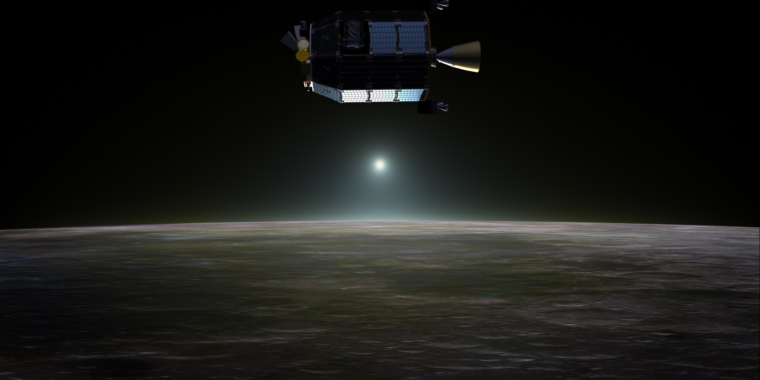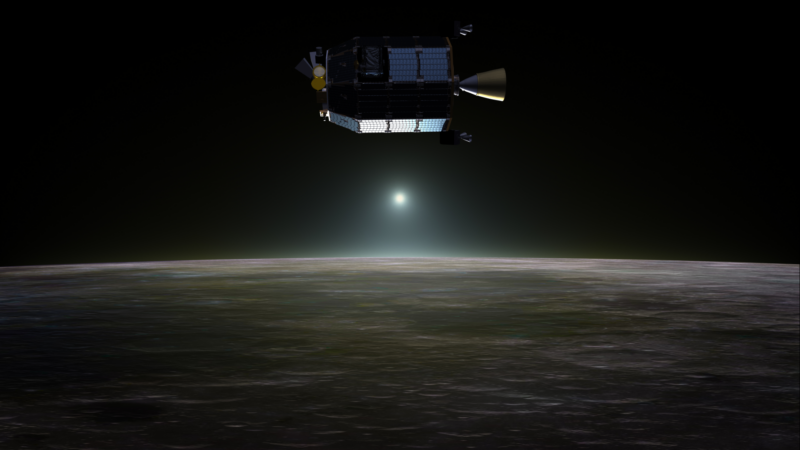Meteorites give the Moon its extremely thin atmosphere

The exosphere gets the vapors —
Impacts that vaporize bits of the lunar surface maintain the Moon’s thin atmosphere.

Enlarge / Artist’s rendition of the LADEE mission above the lunar surface.
The Moon may not have much of an atmosphere, mostly because of its weak gravitational field (whether it had a substantial atmosphere billions of years ago is debatable). But it is thought to presently be maintaining its tenuous atmosphere—also known as an exosphere—because of meteorite impacts.
Space rocks have been bombarding the Moon for its 4.5-billion-year existence. Researchers from MIT and the University of Chicago have now found that lunar soil samples collected by astronauts during the Apollo era show evidence that meteorites, from hulking meteors to micrometeoroids no bigger than specks of dust, have launched a steady flow of atoms into the exosphere.
Though some of these atoms escape into space and others fall back to the surface, those that do remain above the Moon create a thin atmosphere that keeps being replenished as more meteorites crash into the surface.
“Over long timescales, micrometeorite impact vaporization is the primary source of atoms in the lunar atmosphere,” the researchers said in a study recently published in Science Advances.
Ready for launch
When NASA sent its orbiter LADEE (Lunar Atmosphere and Dust Environment Explorer) to the Moon in 2013, the mission was intended to find out the origins of the Moon’s atmosphere. LADEE observed more atoms in the atmosphere during meteor showers, which suggested impacts had something to do with the atmosphere. However, it left questions about the mechanism that converts impact energy into a diffuse atmosphere.
To find these answers, a team of MIT and University of Chicago researchers, led by professor Nicole Nie of MIT’s Department of Earth, Atmospheric and Planetary Sciences, needed to analyze the isotopes of elements in lunar soil that are most susceptible to the effects of micrometeoroid impacts. They chose potassium and rubidium.
Potassium and rubidium ions are especially prone to two processes: impact vaporization and ion sputtering.
Impact vaporization results from particles colliding at high speeds and generating extreme amounts of heat that excite atoms enough to vaporize the material they are in and send them flying. Ion sputtering involves high-energy impacts that set atoms free without vaporization. Atoms that are released by ion sputtering tend to have more energy and move faster than those released by impact vaporization.
Either of these can create and maintain the lunar atmosphere in the wake of meteorite impacts.
So, if atoms sent into the atmosphere by ion sputtering have an energy advantage, then why did the researchers find that most atoms in the atmosphere actually come from impact vaporization?
Touching back down
Since the lunar soil samples provided by NASA had previously had their lighter and heavier isotopes of potassium and rubidium quantified, Lie’s team used calculations to determine which collision process is more likely to keep different isotopes from fleeing the atmosphere.
The researchers found that atoms transferred to the atmosphere by ion sputtering are sent zooming at such high energies that they often reach escape velocity—the minimum velocity needed to escape the Moon’s already feeble gravity—and continue to travel out into space. Atoms that end up in the atmosphere can also be lost from the atmosphere, after all.
The fraction of atoms that reach escape velocity after impact vaporization depends on the temperature of those atoms. Lower energy levels associated with impact vaporization result in lower temperatures, which give atoms a lower chance of escape.
“Impact vaporization is the dominant long-term source of the lunar atmosphere, likely contributing more than 65 percent of atmospheric [potassium] atoms, with ion sputtering accounting for the rest,” Lie and her team said in the same study.
There are other ways atoms are lost from the lunar atmosphere. It is mostly lighter ions that tend to stick around in the exosphere, with ions falling back to the surface if they’re too heavy. Others are photoionized by electromagnetic radiation from the solar wind and often carried off into space by solar wind particles.
What we’ve learned about the lunar atmosphere through lunar soil could influence studies of other bodies. Impact vaporization has already been found to launch atoms into the exosphere of Mercury, which is thinner than the Moon’s. Studying Martian soil, which may land on Earth with sample return missions in the future, could also give more insight into how meteorite impacts affect its atmosphere.
As we approach a new era of manned lunar missions, the Moon may have more to tell us about where its atmosphere comes from—and where it goes.
Science Advances, 2024. DOI: 10.1126/sciadv.adm7074



